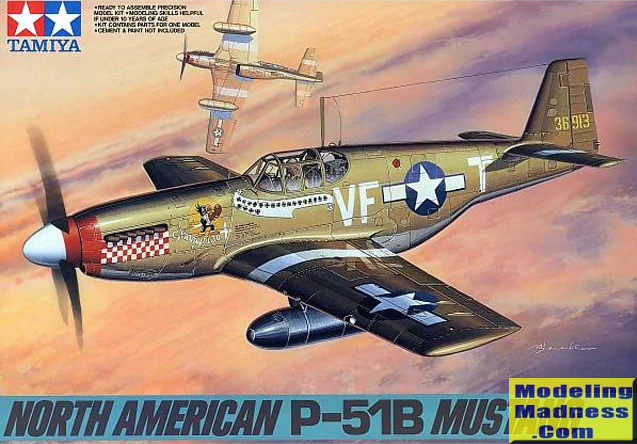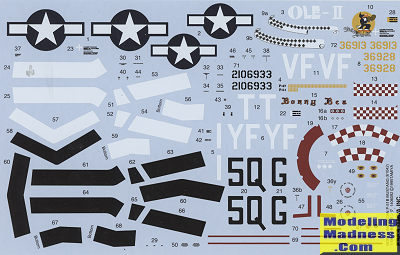
| KIT #: | 61042 |
| PRICE: | $23.95 |
| DECALS: | Three options |
| REVIEWER: | Scott Van Aken |
| NOTES: |

| HISTORY |
Other than the installation of the Merlin engine, the P-51B/C aircraft was subject to a number of modifications to take care of various issues and to improve the range of the plane. Despite modifications, the P-51Bs and P-51Cs, and the newer P-51Ds and P-51Ks, experienced a low-speed handling problems that could result in an involuntary "snap-roll" under certain conditions of air speed, angle of attack, gross weight, and center of gravity. Several crash reports tell of P-51Bs and P-51Cs crashing because horizontal stabilizers were torn off during maneuvering. As a result of these problems, a modification kit consisting of a dorsal fin was manufactured. The type was also fitted with metal elevators to help combat issues with the plane 'porposing' thanks to the additional weight of fuel in the new fuselage tank.
Allied strategists quickly exploited the long-range fighter as a bomber escort. It was largely due to the P-51 that daylight bombing raids deep into German territory became possible without prohibitive bomber losses in late 1943. P-51Bs and P-51Cs started to arrive in England in August and October 1943. The P-51B/P-51C versions were sent to 15 fighter groups that were part of the 8th and 9th Air Forces in England and the 12th and 15th in Italy (the southern part of Italy was under Allied control by late 1943). Other deployments included the China Burma India Theater (CBI). The first group to fly the P-51 on operations was the 354th Operations Group; their first long-distance escort mission was flown on January 15, 1944.
| THE KIT |
When Tamiya first issued this kit in 1995, it was very well received by modelers. Prior to this, the only early Merlin Mustang was the Monogram kit. Now that wasn't a bad thing as most of us are aware that Monogram 1/48 kits are ones that still build into very nice models. But Tamiya added their superb engineering and several decades of improvements in the industry to provide a kit that is still arguably the best around for this variant.
Thankfully, Tamiya chose not to use colored plastic for this one. The interior is superbly done with all that most modelers need. While the decal for the instrument panel and seat harness were still a few kits away, some detail painting will take care of the first and the included pilot figure will do well to hide the second for those who do not want to use aftermarket belts.
Like their P-51D, the cockpit 'tub' includes the molded in radios and fuel tank along with the housing for the ventral radiator. Tamiya has added detail to the interior sidewalls that will benefit from some painting and dry-brushing. Once all that has been done, the cockpit/radiator assembly is trapped in the fuselage halves, after opening some radio mast holes. Tamiya has thoughtfully added two types of exhaust one having the covers and the other without. These can be added after painting and decalling. The upper cowling and lower intake lip are separate so no seam issues there.
When it comes to the wings, there are inserts for the large section of the gear wells. Tamiya, along with almost every other P-51 kit maker before, does not properly represent the aft gear well, having it follow the openings instead of leading straight. I believe only the current Airfix 1/48 P-51D has this correct. Once the upper wing halves are installed, the wings and tailplanes can be added, making for a rather complete airframe. Don't forget to open the holes in the lower wings if you want the wing racks.
Tamiya has provided separate flaps and lower radiator exhaust door so you can mold those up or down. Really, most Mustangs on the ground will have lowered flaps. There is something supposedly inaccurate about Tamiya's flaps, but what it is escapes me at the moment.
There are separate wheel hubs for the outside of each wheel to help ease painting and the kit comes with diamond tread wheels. Inner main gear doors include the retraction struts while the outer doors attach directly to the struts. The tail wheel doors are molded onto the fuselage and one simply installes the one-piece tail gear/wheel.
Tamiya chose to do the prop blades
separately and you have cuffed Hamilton Standard blades, which was the norm
for the early Merlins. A polycap hidden in the spinner allows the prop to be
installed at the end of the build. The cockpit canopy is provided in two
states. One is with the windscreen and canopy as one piece for the closed
 option.
For the open choice this is divided into three sections. Tamiya also
provides an early and late radio mast as well as a rear view mirror for atop
the windscreen.
option.
For the open choice this is divided into three sections. Tamiya also
provides an early and late radio mast as well as a rear view mirror for atop
the windscreen.
Decals are provided for three options, two of them fairly well known. In OD over Neutral grey is Don Gentile'splane from the 336 FS as shown on the box art. In the same colors is Bill Hodve's 358 FS 'Ole-II'. These planes have white wings stripes with the second having a fin stripe and white nose. In unpainted metal is 'Bonnie Bea' of the 339 FS. Its stripes are in black and it has a checkered nose band. The decals are nicely done and include the required stripes.
| CONCLUSIONS |
Not really much to add. It is a Tamiya kit, it is reasonably priced and it is most people's choice for an early Merlin Mustang.
| REFERENCESJ |
https://en.wikipedia.org/wiki/North_American_P-51_Mustang_variants
June 2018
Copyright ModelingMadness.com If you would like your product reviewed fairly and fairly quickly, please
contact
the editor or see other details in the
Note to
Contributors.
Back to the Main Page
Back to the Review
Index Page
Back to the Previews Index Page